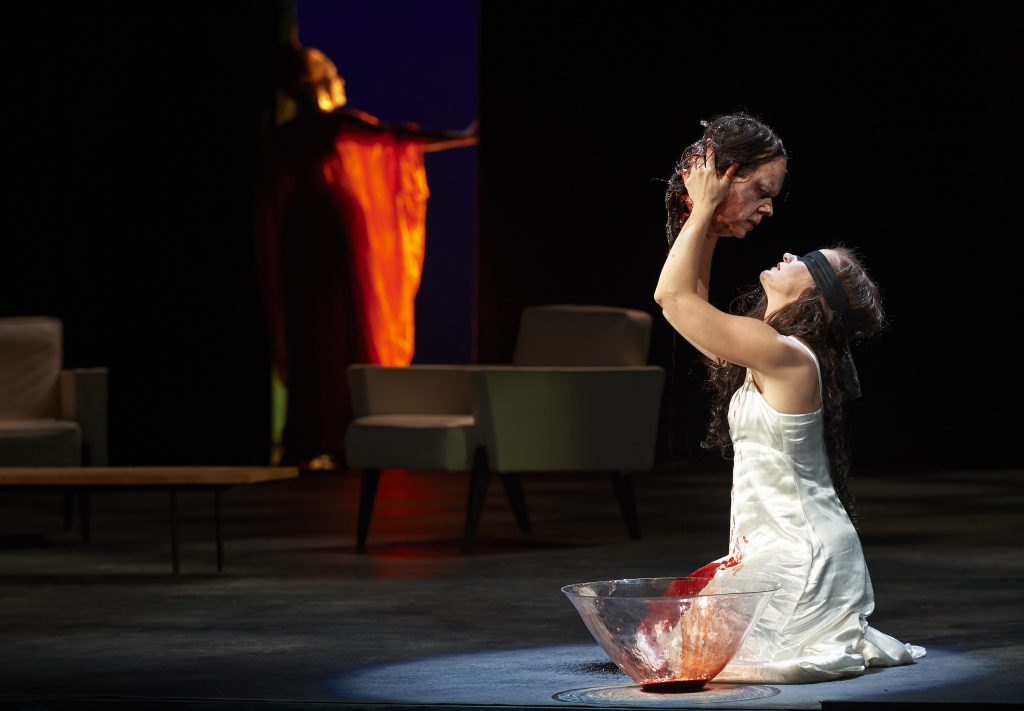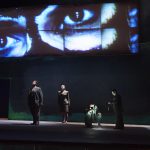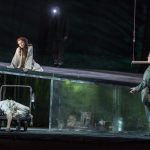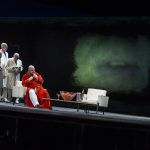In 1891, Oscar Wilde wrote the first of several characteristic signature plays that were to secure his reputation as a social iconoclast. Originally scheduled to premiere in Paris, Salome was hurriedly translated into English by Wilde’s lover, Lord Alfred Douglas, and rushed into London rehearsals. Sarah Bernhardt was to star. But British censors had other plans. Wilde’s play, with its gallery of grotesqueries, was refused a licence for presentation on the English stage. Europe’s creative community was outraged. Must-see performances rippled across the continent. In 1902, the composer Richard Strauss witnessed the notoriously licentious drama in Berlin and immediately grasped its operatic potential. Setting a libretto of his own creation to music cast in the newly avant garde atonal style, Strauss’s gripping adaptation proved to be as popular as it was sensational. It would not be until 1931 that the Lord Chamberlain’s ban on Salome was lifted in Britain. By then play and opera both had acquired the status of twentieth century classics.
In a revival of his controversial 1996 production produced again in 2002, director Atom Egoyan demonstrates his determination to build a new theatrical superstructure on top of Salome’s traditionally durable theatrical foundations. The current Canadian Opera Company spring 2013 presentation revisits a renovation gone seriously sideways.
Directors, of course, have no master set of reference plans to consult when it comes to staging opera other than the existing text. In the case of Salome, Strauss’s all telling wrap around recitatives are already honed to a razor’s edge. Egoyan’s layering of new context — Salome’s lost childhood evoked by projected images of a little girl on a swing— needlessly blurs the more than sufficient psychodrama already set in place by the composer. The unnecessary addition of an imagined backstory dramatically shifts our attention away from the opera’s essential erotic core. Seen from Egoyan’s pov, Salome is less mistress of her own desires, more hapless victim.
To create his Salome, Richard Strauss stripped Wilde’s play to its primal essence.
Salome, princess of Judea, is passionately obsessed with the voice of the prophet Jochanaan (John the Baptist) whom her stepfather, the deceitful King Herod, is holding captive in a vault beneath his palace. Seducing Narraboth, captain of the guard, into revealing the prisoner, Salome falls victim to the holy man’s allure. She begs him to let her kiss his mouth. Jochanaan is repulsed. Cursing and damning Salome, he slips back into his subterranean cell.
Herod and his wife Herodias, mother to Salome, enter with their court in search of the princess. Herod commands Salome’s attendance at his banquet that night. The lustful, debauched ruler blatantly flirts with his stepdaughter. Jochanaan is heard warning of God’s impending judgement. Herod, who secretly fears the prophet, provokes an uproarious dispute among a group of Jewish advisors concerning Jochanaan’s spirituality. Pushed beyond her patience by husband and courtiers alike, Herodias screams for silence. Weary and troubled, Herod begs Salome to dance for him. Salome agrees in return for Herod’s oath to grant her her heart’s desire.
Salome performs the Dance of the Seven Veils. Herod is delighted. Salome claims her reward. Jochanaan’s head. Herod is horrified but Salome is resolute. No number of less gruesome, more tantalizing gifts can tempt her to change her mind. Herod relents. Jochanaan is executed by a swordsman and his head brought to Salome. Lost in a deep ecstatic trance, Salome caresses the head as if it were alive, bitterly chastising Jochanaan for rejecting her. Frenzied and aroused, she presses her lips to the dead man’s mouth. Herod is sickened, calling her act that of a monster. At his command, Salome is put to death.
There are times in Egoyan’s treatment of Richard Strauss’s twisted tale when simplistic physical staging stands in for deeper, more ambiguous human psychology. Herod’s manic hallucinations are the product of an overdue heroin injection. Jochanaan’s obliviousness to Salome’s irresistible sexuality is due to a blindfold. Most of these vignettes, offered with cool, detached observation, are fundamentally unsatisfying. For the most part, memorable scenes where character, action and emotion connect are moments where well enough is left alone. Salome’s shadowy, less-is-more Dance of the Seven Veils. The tense, quarrelsome chorus that is the Five Jews.
What worked so effectively for Egoyan cinematically in films like Exotica (1994) and The Sweet Hereafter (1997), the gradual agonizing revelation of subtext and repressed motivation, is less suited to the blunt, hyper-accelerated action of Strauss’s explosive one act spectacle. Salome is like a nightmare, tempting to analyze, but ultimately an experience that exists beyond rational understanding. Like all great opera, this is one supercharged encounter with high emotion best confronted from the edge of a seat.
In the title role of Salome, Swedish-American Erika Sunnegårdh sings with fearless commitment, plunging deep into Strauss’s terrifying music, journeying wherever it may lead. The assignment is daunting. Salome’s singing ranges from a breath-taking high B to an anguished low G, a vocal span more dramatic soprano than mezzo, more mezzo contralto than soprano. Miss Sunnegårdh takes every note in her stride. Her voice, indeed all voices in this Salome’s cast, redeems a good many shortcomings in the COC/Vancouver/Houston co-production. Silky and sensuous, flinty and cutting, Sunnegårdh has a control and flexibility of remarkable dimensions. Pitch is flawless. Nothing is withheld.
Better known as a lighter lyric tenor lead with deep roots in Italian grand opera, Canadian Richard Margison tackles Salome’s King Herod for the first time in his career. In an interview with CBC Radio, Margison admitted the role is arguably the most difficult vocal challenge he has ever undertaken. Strauss’s rhythmic and melodic demands are completely alien to those of Verdi or Puccini, composers with whom he is more accustomed. Singing in German seemed equally disorienting at first, he confessed. Clearly none of the popular Canadian artist’s misgivings have found their way into his performance. As a shifty, paranoid Herod, Margison sings at the top of his game, restlessly prowling his gloomy palace, seducing, bullying, whining. The characterization is riveting, the vocalization stunning. There is a kind of rich, robust menace to the voice overlaid with a canopy of fresh bright top notes, snarly when necessary, seductive at others. Dangerous. Margison is magnificent.
As Jochanaan, baritone Alan Held, sharing the Prophet with Martin Gantner, performs with commanding presence, booming, bassy and full of scorn. Exceptional.
Hanna Schwarz delivers a Herodias crackling with evil. Adrian Thompson, Michael Colvin, Michael Barrett, Adam Luther and Jeremy Milner are an eternally combative cabal of scholar/doctors dressed in white lab coats. What begins in comedy with the Five Jews ends in horror. A persuasively unnerving ensemble.
Music director Johannes Debus leads the COC orchestra expanded to a staggering 106 musicians. The unsurpassed acoustics of Toronto’s glorious Four Seasons Centre channel the full mass of Strauss’s towering symphonic sound with almost physical intensity. Salome’s famous leitmotifs, about which there is absolutely no apparent agreement when it comes to labelling the lush recurring melodies, are conducted and played with dazzling luminosity. Strauss’s music, like his libretto, transcends the need for explanation.
Time has not been kind to this production. Cutting edge mid-1990s stagecraft — film projection, chiaroscuro lighting, visible set machinery — unique, daring techniques sixteen years ago, simply look tired and tawdry today. True, Egoyan has given his Salome a slight update. Designer Clea Minaker, a former puppeteer with Feist’s 2008 concert team, has been imported to create a rear screen shadow play environment for the Dance of the Seven Veils. Technically, the new approach works well. But the facelift is limited and less than skin deep. The same big creative issues that plagued this Salome when it first opened still remain.
Director Atom Egoyan’s heavy-handed opera regie plan of attack comes very close to collapsing the COC’s latest offering. The best of what remains standing is a testament to a superbly talented cast and orchestra. And the steadfast power of Richard Strauss’s enduring masterpiece.








